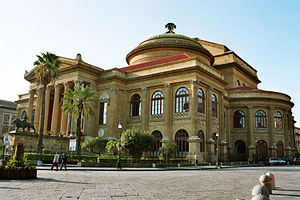Ernesto Basile
Ernesto Basile | |
|---|---|
Kingdom of Italy | |
| Nationality | Italian |
| Known for | Architecture |
| Notable work | Teatro Massimo, Palazzo Montecitorio |
| Movement | Art Nouveau |
Ernesto Basile (31 January 1857 – 26 August 1932, in Palermo) was an Italian architect and an exponent of modernisme and Liberty style, the Italian variant of Art Nouveau. His style was known for its eclectic fusion of ancient, medieval and modern elements.[1]
Life
He was born in Palermo to a father
Giovanni Battista Filippo Basile was also an architect and a professor at the University of Palermo. Ernesto graduated in 1878 as an architect in Palermo in the Royal School of Engineering and Architecture (Italian: Regia Scuola di Applicazione per Ingegneri e Architetti).[2] During the 1880s he lived in Rome. There in 1887 he married Ida Negrini and became assistant professor at the University of Rome.[2] In the following years he was appointed professor of technical architecture in the University of Rome. At that period of his life he travelled in Brazil and in Spain. In 1890 he succeeded his father Giovanni, who died in 1891, as a professor of architecture.[2]
Ernesto Basile died on 26 August 1932 in Palermo.
Career
After graduation Basile took part in many architecture competitions. Ernesto Basile created a stylistic hybrid consisting of Roman, Norman and Arab influences. His father had started the construction of the opera house
Cassa Centrale di Risparmio in Palermo.[2][3] In 1913-14 he built the Kursaal Biondo theatre, which had asymmetrical Baroque elements, in Palermo.[2]
Notable works


- Villino Basile in collaboration with his father Giovanni Basile, 1874–78.
- National Exhibition in Arab-Norman style, 1891–92.
- Memorial in Calatafimi-Segesta, in order to commemorate the victory of Giuseppe Garibaldi against the Bourbons, 1892.
- Teatro Massimo in Palermo, 1891–97.[2]
- Palazzo Francavilla, renovation, 1893
- Villa Firriato in Canicattì, 1898.
- Social theatre in Canicattì, 1898.
- Florio Vincenzo villa in Palermo, 1899.
- Grand Hotel Villa Igiea in Palermo, 1899–1900.
- Villino Florio in Palermo, 1899–1902.
- Tomba Raccuglia in Palermo, 1900.
- Cappella Lanza di Scalea, 1900.
- Italian Chamber of Deputies in Rome, 1903–27.[2]
- Villino Fassini in Palermo, 1903.
- Villino Ida Basile (named after his wife Ida Negrini), 1903–04.[1]
- Villa dei Principi Deliella, 1905–07.
- Stand Florio in Palermo, 1906.
- Municipal Hall of Licata, 1906.
- Palazzo Bruno di Belmonte in Ispica, 1906.
- Florio Pavilion in Milan, 1906.
- Centre of electric power in Caltagirone, 1907.
- Expansion of Grand Hotel in Palermo, 1907.
- Palazzo della Cassa Centrale di Risparmio in Palermo, 1907–12.
- Square of the Sardinian in Messina, 1909.[1]
- Villa Manganelli in Catania, 1909–14.
- Palazzo delle Assicurazioni Generali Venezia in Palermo, 1912.
- Town Hall of Reggio Calabria, 1918–21.[1]
- Kursaal Biondo theatre in Palermo, 1913–14.[1]
- Cassa di Risparmio in Messina, 1926–27.
- Church of Saint Rosalia in Palermo, 1928.
Writings
- Sculptures and plasters of Giacomo Serpotta (Italian: Le sculture e gli stucchi di Giacomo Serpotta), 1911.[4]
- Architecture and the beginnings of its renewal (Italian: Architettura dei suoi principii e del suo rinnovamento), 1882.[4]
References
- ^ ISBN 1-56898-438-3
- ^ ISBN 3-8228-6312-2
- ^ "Official government website of Palermo". Archived from the original on January 7, 2009.
- ^ a b Gianni Pirrone (1976), Studies and sketches of Ernesto Basile, Sellerio
External links
Wikimedia Commons has media related to Ernesto Basile.
